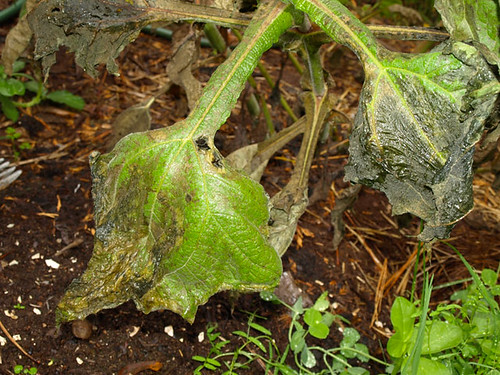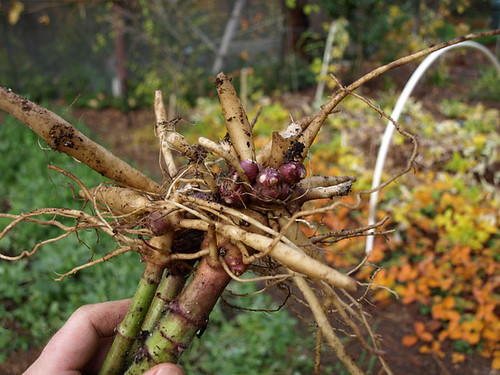 The first frost arrived a couple of weeks ago, damaging the leaves of the Bolivian sunroot (also called yacón) – no surprise there. I’ve grown this plant for years – I like the tubers, which have a subtle flavor that tastes to me like carrot, celery and that good part of the watermelon rind between the red flesh and the hard outer shell. Frost supposedly makes the tubers sweeter, and I think that’s true – they also taste better and better the longer they remain in the crisper drawer.
The first frost arrived a couple of weeks ago, damaging the leaves of the Bolivian sunroot (also called yacón) – no surprise there. I’ve grown this plant for years – I like the tubers, which have a subtle flavor that tastes to me like carrot, celery and that good part of the watermelon rind between the red flesh and the hard outer shell. Frost supposedly makes the tubers sweeter, and I think that’s true – they also taste better and better the longer they remain in the crisper drawer.
The plant is perennial, but it never seems to overwinter in the ground in my garden – it just rots away. Every year, after the first frost, I dig the plants up, remove and wash the tubers, and then divide up the rhizomes (the reddish nubs at the base of the stem and above the tubers from which the aerial shoots form), storing them in a bucket of sand or potting soil in a shed to prevent them from freezing. In the spring, after the last frost, I plant them out in full sun, ideally in a deep, loose soil. As a large-leaved plant, Bolivian sunroot is a bit of a water hog.
 This year, I decided to try leaving a few yacón rhizomes in the ground. I mulched them heavily with straw, hopefully to protect them from freezing, so perhaps they’ll suffer the winter and resprout in the spring. Next season, remind me to try making (reportedly healthy) tea from the leaves.
This year, I decided to try leaving a few yacón rhizomes in the ground. I mulched them heavily with straw, hopefully to protect them from freezing, so perhaps they’ll suffer the winter and resprout in the spring. Next season, remind me to try making (reportedly healthy) tea from the leaves.
Speaking of Andean vegetables, years ago I tried growing oca (Oxalis tuberosa), but it wasn’t especially happy in my garden. This spring, I’d like to try again, and also plan to give mashua and ulluco a shot.


Pingback: A Seed Library, Andean Vegetables, and How To Fold a Seed Bindle | food|forest|garden